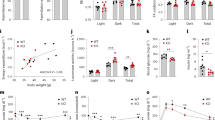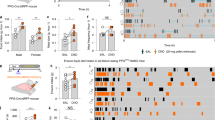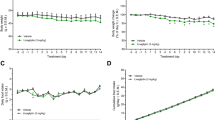Abstract
Objective:
Sugar consumption has increased markedly over the last few decades and parallels the dramatic increase in overweight and obesity. Data obtained from animal studies suggest that the intestinal serotonergic system and herein particularly the serotonin receptor 3 (5-HT3R) may be involved in sugar detection and short-term control of food intake. Using a mouse model, we tested the hypothesis that blocking 5-HT3R prevents the development of sugar-induced obesity.
Design:
For 8 weeks, C57BL/J6 mice were offered either water containing 30% glucose or plain water in addition to normal chow. The effect of oral treatment with the 5-HT3R antagonist, tropisetron (0.2 mg kg−1 body weight), on body weight and caloric intake was studied.
Results:
Total caloric intake and weight gain were significantly increased in mice fed glucose compared with the control group. Tropisetron treatment reduced intestinal motility and almost completely blocked weight gain associated with glucose feeding; however, total caloric intake was not affected. The effect of tropisetron was not associated with a decreased expression of the intestinal and hepatic glucose transporters, SGLT1 (sodium-dependent glucose cotransporter) and Glut2 (glucose transporter 2); instead, the expression of these transporters was slightly increased by the 5-HT3R antagonist. However, expressions of carbohydrate responsive element binding protein and fatty acid synthase, as well as triglyceride levels in the liver were only enhanced in mice fed glucose, but remained unchanged at the level of the control group when mice were treated concomitantly with tropisetron. At the same time, β-hydroxybutyrate dehydrogenase mRNA expression and plasma levels of ketone bodies were significantly increased.
Conclusion:
Our results suggest that 5-HT3R is a new target for the modulation of hepatic glucose metabolism and for the prevention of obesity.
This is a preview of subscription content, access via your institution
Access options
Subscribe to this journal
Receive 12 print issues and online access
$259.00 per year
only $21.58 per issue
Buy this article
- Purchase on Springer Link
- Instant access to full article PDF
Prices may be subject to local taxes which are calculated during checkout





Similar content being viewed by others
References
Olufadi R, Byrne CD . Clinical and laboratory diagnosis of the metabolic syndrome. J Clin Pathol 2008; 61: 697–706.
Astrup A . Dietary management of obesity. JPEN J Parenter Enteral Nutr 2008; 32: 575–577.
Gross LS, Li L, Ford ES, Liu S . Increased consumption of refined carbohydrates and the epidemic of type 2 diabetes in the United States: an ecologic assessment. Am J Clin Nutr 2004; 79: 774–779.
Schulze MB, Manson JE, Ludwig DS, Colditz GA, Stampfer MJ, Willett WC et al. Sugar-sweetened beverages, weight gain, and incidence of type 2 diabetes in young and middle-aged women. JAMA 2004; 292: 927–934.
Spitzer L, Rodin J . Effects of fructose and glucose preloads on subsequent food intake. Appetite 1987; 8: 135–145.
Brito VB, Folmer V, Soares JC, Silveira ID, Rocha JB . Long-term sucrose and glucose consumption decreases the delta-aminolevulinate dehydratase activity in mice. Nutrition 2007; 23: 818–826.
Lindqvist A, Baelemans A, Erlanson-Albertsson C . Effects of sucrose, glucose and fructose on peripheral and central appetite signals. Regul Pept 2008; 150: 26–32.
Bergheim I, Weber S, Vos M, Kramer S, Volynets V, Kaserouni S et al. Antibiotics protect against fructose-induced hepatic lipid accumulation in mice: role of endotoxin. J Hepatol 2008; 48: 983–992.
Sclafani A . Carbohydrate-induced hyperphagia and obesity in the rat: effects of saccharide type, form, and taste. Neurosci Biobehav Rev 1987; 11: 155–162.
Blundell JE, Latham CJ . Serotonergic influences on food intake: effect of 5-hydroxytryptophan on parameters of feeding behaviour in deprived and free-feeding rats. Pharmacol Biochem Behav 1979; 11: 431–437.
Simansky KJ, Sisk FC, Vaidya AH, Eberle-Wang K . Peripherally administered alpha-methyl-5-hydroxy-tryptamine and 5-carboxamidotryptamine reduce food intake via different mechanisms in rats. Behav Pharmacol 1989; 1: 241–246.
Sugimoto Y, Yoshikawa T, Yamada J . Effects of peripheral administration of 5-hydroxytryptamine (5-HT) on 2-deoxy-D-glucose-induced hyperphagia in rats. Biol Pharm Bull 2002; 25: 1364–1366.
Raybould HE, Glatzle J, Robin C, Meyer JH, Phan T, Wong H et al. Expression of 5-HT3 receptors by extrinsic duodenal afferents contribute to intestinal inhibition of gastric emptying. Am J Physiol Gastrointest Liver Physiol 2003; 284: G367–G372.
Zhu JX, Zhu XY, Owyang C, Li Y . Intestinal serotonin acts as a paracrine substance to mediate vagal signal transmission evoked by luminal factors in the rat. J Physiol 2001; 530: 431–442.
Savastano DM, Carelle M, Covasa M . Serotonin-type 3 receptors mediate intestinal polycose- and glucose-induced suppression of intake. Am J Physiol Regul Integr Comp Physiol 2005; 288: R1499–R1508.
Savastano DM, Covasa M . Intestinal nutrients elicit satiation through concomitant activation of CCK(1) and 5-HT(3) receptors. Physiol Behav 2007; 92: 434–442.
Bischoff SC, Mailer R, Pabst O, Weier G, Sedlik W, Li Z et al. Role of serotonin in intestinal inflammation: knockout of serotonin reuptake transporter exacerbates 2,4,6-trinitrobenzene sulfonic acid colitis in mice. Am J Physiol Gastrointest Liver Physiol 2009; 296: G685–G695.
Drewnowski A, Bellisle F . Liquid calories, sugar, and body weight. Am J Clin Nutr 2007; 85: 651–661.
Malik VS, Schulze MB, Hu FB . Intake of sugar-sweetened beverages and weight gain: a systematic review. Am J Clin Nutr 2006; 84: 274–288.
Raben A, Vasilaras TH, Moller AC, Astrup A . Sucrose compared with artificial sweeteners: different effects on ad libitum food intake and body weight after 10 wk of supplementation in overweight subjects. Am J Clin Nutr 2002; 76: 721–729.
Kanarek RB, Orthen-Gambill N . Differential effects of sucrose, fructose and glucose on carbohydrate-induced obesity in rats. J Nutr 1982; 112: 1546–1554.
Sclafani A, Xenakis S . Sucrose and polysaccharide induced obesity in the rat. Physiol Behav 1984; 32: 169–174.
Bravo G, Maswood S . Acute treatment with 5-HT3 receptor antagonist, tropisetron, reduces immobility in intact female rats exposed to the forced swim test. Pharmacol Biochem Behav 2006; 85: 362–368.
Nguyen H, Wang H, le T, Ho W, Sharkey KA, Swain MG . Downregulated hypothalamic 5-HT3 receptor expression and enhanced 5-HT3 receptor antagonist-mediated improvement in fatigue-like behaviour in cholestatic rats. Neurogastroenterol Motil 2008; 20: 228–235.
Fuller RW . Serotonin uptake inhibitors: uses in clinical therapy and in laboratory research. Prog Drug Res 1995; 45: 167–204.
Wurtman JJ, Wurtman RJ . Fenfluramine and fluoxetine spare protein consumption while suppressing caloric intake by rats. Science 1977; 198: 1178–1180.
Ricca V, Mannucci E, di BM, Rizzello SM, Cabras PL, Rotella CM . Sertraline enhances the effects of cognitive-behavioral treatment on weight reduction of obese patients. J Endocrinol Invest 1996; 19: 727–733.
Halford JC, Harrold JA, Boyland EJ, Lawton CL, Blundell JE . Serotonergic drugs: effects on appetite expression and use for the treatment of obesity. Drugs 2007; 67: 27–55.
Rosenzweig-Lipson S, Zhang J, Mazandarani H, Harrison BL, Sabb A, Sabalski J et al. Antiobesity-like effects of the 5-HT2C receptor agonist WAY-161503. Brain Res 2006; 1073–1074: 240–251.
Grignaschi G, Invernizzi RW, Fanelli E, Fracasso C, Caccia S, Samanin R . Citalopram-induced hypophagia is enhanced by blockade of 5-HT(1A) receptors: role of 5-HT(2C) receptors. Br J Pharmacol 1998; 124: 1781–1787.
Wolf H . Preclinical and clinical pharmacology of the 5-HT3 receptor antagonists. Scand J Rheumatol Suppl 2000; 113: 37–45.
Kishi K, Tanaka T, Igawa M, Takase S, Goda T . Sucrase-isomaltase and hexose transporter gene expressions are coordinately enhanced by dietary fructose in rat jejunum. J Nutr 1999; 129: 953–956.
Iizuka K, Horikawa Y . ChREBP: a glucose-activated transcription factor involved in the development of metabolic syndrome. Endocr J 2008; 55: 617–624.
Davies MN, O’Callaghan BL, Towle HC . Glucose activates ChREBP by increasing its rate of nuclear entry and relieving repression of its transcriptional activity. J Biol Chem 2008; 283: 24029–24038.
Tsatsos NG, Towle HC . Glucose activation of ChREBP in hepatocytes occurs via a two-step mechanism. Biochem Biophys Res Commun 2006; 340: 449–456.
Acknowledgements
This study was supported, in part, by grants from the Institute DANONE fuer Ernaehrung (to SCB and SW), the Ministry of Science, Research and the Arts of Baden-Württemberg (Az: 24-753222-11-13/2) (to SCB and IB), and the Competence Network of Obesity, reserach focus ‘Obesity and the GI tract’, funded by the Federal Ministry of Education and Research (No. 01GI0843) (to SCB).
Author information
Authors and Affiliations
Corresponding author
Rights and permissions
About this article
Cite this article
Weber, S., Volynets, V., Kanuri, G. et al. Treatment with the 5-HT3 antagonist tropisetron modulates glucose-induced obesity in mice. Int J Obes 33, 1339–1347 (2009). https://doi.org/10.1038/ijo.2009.191
Received:
Revised:
Accepted:
Published:
Issue Date:
DOI: https://doi.org/10.1038/ijo.2009.191
Keywords
This article is cited by
-
Reciprocal control of obesity and anxiety–depressive disorder via a GABA and serotonin neural circuit
Molecular Psychiatry (2021)
-
Blocking serotonin receptor 3 prevents glucose-induced obesity in mice
Nature Reviews Gastroenterology & Hepatology (2010)



